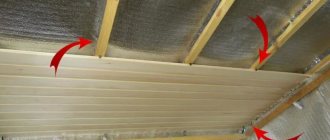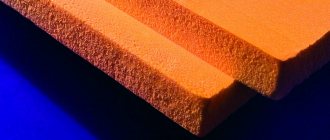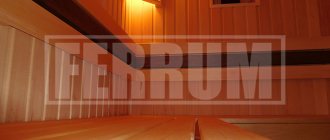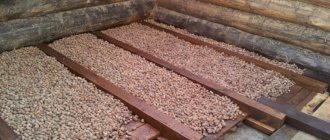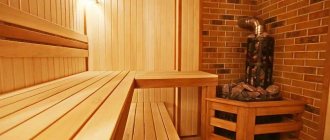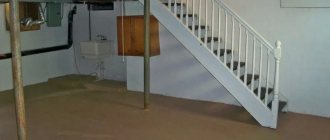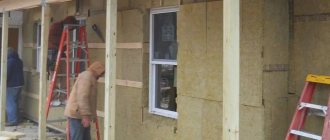The floor in the washing room of the bathhouse heats up much more slowly in winter than in the steam room. For this reason, it is not always comfortable to perform water procedures in a washing room after a steam room. Therefore, it will be useful for building owners to understand how to insulate the floor of a bathhouse in a washroom with their own hands. Read to the end and find out the features of this room. We will also tell you about the types and requirements for the floor in the sink, help you choose a heat insulator for such building structures and consider the processes of their insulation.
Comfortable heated floor in the washroom Source oboiman.ru
Distinctive features of the washing room and the floor in it
A bathhouse is a building that is highly exposed to water. However, it is the washing room in such a structure that is the room where there is the most moisture. There is also a strong temperature difference here, which is especially noticeable in winter.
Usually a person visits the washing department several times while in the bathhouse. He constantly enters it from the steam room to douse himself with cool water. In this case, the liquid always falls on the floor and leaves through it. Therefore, moisture regularly penetrates into the pores of wooden elements of building structures.
The bathhouse is not heated regularly. For this reason, during the winter, the water in the lumber periodically thaws and freezes. Therefore, there is a gradual destruction of the wood from which the floor parts and other building structures are made.
Excess moisture negatively affects all wooden elements of the washing machine Source vip-1gl.ru
Due to changes in temperature and constant humidity in the washing room, special requirements are placed on the floor in this room:
- effective drainage of water by installing a slope to the drain ladder or constructing a leaky structure;
- high resistance to rot and sudden temperature changes;
- minimal ability to absorb moisture and greater strength;
- maximum heating and drying in a short period of time;
- anti-slip surface even when very wet.
It is possible to meet all the requirements only if the floor is constructed correctly. Therefore, even at the stage of designing a bathhouse, it is necessary to choose its design wisely. To avoid mistakes and anticipate all possible difficulties in advance, it is better to contact a specialized company.
Specialists are able to fully solve the problem. They will create ventilation in the washing room and professionally select all the necessary building materials, which will allow the use of high-quality thermal insulation.
Using high-quality building materials in bathhouse cleaning Source remontik.org
If the floor in the washing room has a lower temperature than the air in the upper zone of this room, then people will feel uncomfortable during water procedures. This deficiency also negatively affects the microclimate of the room and contributes to the occurrence of rot on the wood. To eliminate these problems, experts recommend high-quality thermal insulation of the floor structure.
Which walls are the most durable for a waiting room?
Considering that there is increased condensation in the dressing room, due attention should be paid to the material’s resistance to moisture.
Natural materials withstand moisture best. If it is not possible to purchase just such raw materials, because they are usually expensive, then you can give preference to any material and choose a good product to protect the surface. If it is not possible to purchase just such raw materials, because they are usually expensive, then you can give preference to any material and choose a good surface protection product.
There are quite a lot of similar products in construction stores; you just need to consult with an experienced specialist. Let the bathhouse please you with its aroma and warmth. Only proper preparation for the process of building a bathhouse can make the space complete.
Types of flooring in the sink
There are only 3 types of flooring in the washroom - solid and flowing wood, as well as a tiled covering laid on a concrete base. Each type is subject to insulation. However, this process is performed differently for them. This is due to the design features of each type of floor.
Solid wood floor
This type is a non-drip surface. It is most common in baths. Moreover, this design is one of the warmest floors. In addition, wooden flooring has an attractive texture, high environmental friendliness and low heat conductivity.
Solid wood flooring Source yandex.net
Non-drip decking is primarily created from softwood. This wood is resistant to rot. It also withstands other negative influences. At the same time, no resin comes out of the boards, since the air environment in the sink heats up slightly, compared to a steam room.
However, before you properly make the floors in the bathhouse in the washing room, it is recommended to always remember that when installing non-spillable flooring made of wood, you have to put in significant effort. The reason for this is the lack of removable parts, which forces us to provide effective ventilation at the initial stage of construction. At the same time, solid wooden floorings are often created on a screed made of concrete mortar or soil, which is previously well compacted.
The non-spill floor system includes not only wooden flooring, but also logs with sheathing. In addition, it is also necessary to create waterproofing between all parts. Thermal insulation material is usually laid between horizontally located joists. In this case, the slope of the wooden flooring is created by sheathing.
Continuous flooring on joists Source 9ban.ru
The insulation that is placed between the joists can be in the form of expanded clay or foam with a dense structure. Mineral wool is also often used. At the same time, no attention is paid to the hygroscopicity of the building material used when the heat insulator is reliably protected from the negative effects of water.
To prevent moisture from penetrating through a wooden floor, experts use tongue and groove boards during its construction. At the same time, they must be treated with water-repellent substances. In addition, ventilation of the space under the floor is always created. To do this, a plastic pipe is placed into the underground from the street side. Its diameter can be 50-100 mm.
poured wood floor
This type of decking is a leaky wood surface. Its installation is simpler compared to a solid floor. A distinctive feature of a pourable surface is the absence of a slope, because water is removed through the cracks between the boards. Flowing through them, it ends up in a pit. Then the water flows into the sewer through a pipe laid at an angle.
Dry floor made of planks in the washing room Source kraski-net.ru
A cushion of sand and crushed stone is also placed under the leaking floor, or the soil is simply compacted if the washing compartment in the bathhouse is rarely used. This type of foundation under the deck allows water to drain directly into the ground.
During the construction of a leaking floor, all joists are mounted on reinforced concrete columns. They are also often made from brick. This design allows you to reduce the negative impact of water on wooden logs.
If the bathhouse is often used, then a more reliable base is made under the floor. For this, concrete mortar is usually used. A screed is created from it. In this case, the drainage system with a ladder is first installed. The screed is poured with a slope towards the drain.
When installing a poured floor, the flooring itself is not insulated. The reason for this is that there must be free space underneath so that water can flow freely to the drain hole in the screed. However, to insulate the entire structure, a heat insulator is used during the construction of the concrete base. For this purpose, a heat-insulating filler for the solution or separately expanded clay is often used.
Layed expanded clay under a concrete screed Source dadai.ru
See also: Catalog of companies that specialize in home insulation
When creating a concrete base, do not forget about ventilation. They are usually provided around the perimeter. They are necessary for ventilation.
Important! Expanded clay is not used if a bathhouse is being built on poles.
In order not to add this insulation, first a rough base is made from the boards. For example, mineral wool is laid on it. In this case, the heat insulator must be protected from water on all sides.
Then the sheathing is installed at a slope in the direction of the drainage hole of the drainage system. Then the stainless steel sheets are attached. Their joints overlap. Finally, the finishing flooring is installed from boards. This type of floor requires more money and effort, but it turns out to be more protected from wind and low temperatures.
Tile and concrete floors
Before making bathhouse floors in the washing room, it is recommended not to forget that the option made of tiles and on a concrete base is considered one of the most reliable and durable. Tile is an excellent finish for a sink. It is easy to clean and does not require special care. The tile material also has an aesthetic appearance. In addition, the screed provides high strength to the floor.
Interior of a washroom in a bathhouse Source aviarydecor.com
A tiled floor on a concrete base is installed in the following sequence:
- compact the soil;
- pour gravel or broken brick in a layer the thickness of which is at least 150 mm;
- pour the first layer of cement-sand mortar;
- lay waterproofing and then insulation material;
- cover the heat insulator with waterproofing;
- spread the reinforcing material in the form of a mesh;
- pour the second layer of screed;
- lay tile material.
Making a reinforced screed on the ground Source 24aul.ru
Before creating this floor option, always install a drainage system. When pouring the solution, a slope is necessarily created. Thanks to it, water will flow into the drain. Penoplex or expanded clay are usually used for insulation. These materials can withstand the required loads, which mineral wool cannot boast of.
Frequently asked questions
Some questions that users have can be answered immediately, without waiting for them to arise:
If the floor is wet, is it necessary to install a waterproofing layer over the moisture-proof insulation?
Despite the properties of the heat insulator, it is recommended to cover it with a film to cut off waste water. Over time, the film will develop a layer of slime and can simply be replaced without much expense or labor. It is not practical to change the insulation every year.
If mineral wool is chosen as insulation, how to protect it from water?
The usual technique is used - laying a waterproofing sheet, then mineral wool, on top of which is another layer of polyethylene.
If foil insulation is installed as thermal insulation, will the polyethylene sheet interfere with the passage of reflected infrared rays?
Polyethylene does not interfere with IR rays. However, it is not recommended to use black film; it can cut off some of the rays.
Is it possible to insulate a wooden floor with a layer of expanded clay backfill?
There are no fundamental objections to this matter. Many sources even recommend this option. However, you will have to carefully protect the backfill from water, which is technically difficult and ineffective.
How to lay drain system pipes?
As a rule, they are laid even before the installation of the heat insulator. When laying the pipes, they are covered with pieces of insulation and all cracks and joints are filled with foam, eliminating the possibility of cold bridges.
Selection of insulating material
Professionals always take a responsible approach to choosing insulation for washing in a bathhouse. Typically, a material is used that has minimal hygroscopicity and is resistant to rot. The following heat insulators are most often chosen:
- Foamed polystyrene.
It is a foam plastic and is characterized by a dense structure. Therefore, it is used in the construction of wood and concrete floors. It is also water resistant and lightweight. Plates of this material prevent floor freezing because they have low thermal conductivity. However, their disadvantage is that they are attractive to mice. Therefore, foamed polystyrene is not used if such rodents are found on the site.
Foam Source a.mktgcdn.com
- Penoplex.
This material is similar to polystyrene foam, but is an improved copy of it. It withstands the negative effects of water, retains heat well and is durable. In addition, penoplex does not emit substances that are dangerous to humans and nature.
Penoplex Source namteplo.org.ua
Insulation of a bathhouse from the inside
A feature of the insulation of internal walls in a bathhouse is the high level of humidity. Therefore, even if thermal insulation that is insensitive to moisture is selected, the insulation will need to be securely covered with a layer of vapor barrier. If this is not done, moisture will begin to condense inside the insulating material, which can lead to a decrease in the ability to retain heat and the possibility of rotting of the wall material.
Aluminum foil can be used as a vapor barrier for baths, which not only protects the insulation from condensation, but also largely reflects heat. To ensure the integrity of the vapor barrier, all seams between the sheets of foil should be taped with metallized tape.
Since the conditions in the bathhouse in different rooms differ significantly, the insulation technology will vary significantly.
- Insulation of walls in the steam room.
Here the sequence of actions will be as follows:
- a lathing made of dry wooden beams or slats is hung on the surface of the walls;
- the cells formed by the lathing slats are covered with fiberglass cloth;
- heat-insulating material is laid (basalt is best);
- A layer of vapor barrier is laid on top of everything.
The final stage of insulating the walls in the steam room will be the installation of decorative finishing. As such, it is best to use wooden lining.
Another video about insulating a bathhouse from the inside and how to line a steam room inside.
Ceiling insulation.
This operation is in many ways similar to improving the thermal insulation of walls. The differences will be that when insulating the ceiling in the washing room and in the dressing room, you can refuse to use aluminum foil as a vapor barrier. Instead, it is quite possible to use cheaper polyethylene or kraft paper.
In addition, it is worth leaving a gap of 1-2 cm between the vapor barrier layer and the decorative ceiling cladding. This distance will improve the ventilation of the cladding material to speed up its drying. This point is quite important, since during bathing procedures the ceiling lining is exposed to the destructive effects of moisture at very high temperatures. The presence of a gap will allow the wood not to rot, but to dry out without deteriorating its performance and aesthetic qualities.
You will learn how to insulate a wooden floor in a bathhouse by reading this article.
And this article talks about insulating the roof of a bathhouse.
Floor insulation.
Heat loss in a bathhouse can occur not only through the walls or ceiling, but also through the floor, which is especially important in winter. Therefore, floors must also be carefully insulated. The sequence of actions for floor insulation will be as follows:
- a concrete screed is poured onto the leveled and compacted base of the earthen floor;
- after the screed has hardened, a layer of waterproofing made of dense polyethylene or roofing felt is lined;
- sheets or fabrics of insulation are laid;
- another layer of waterproofing is lined;
- another layer of concrete screed is poured.
Since the floors in the bathhouse are constantly in contact with water, when insulating them, the thoroughness of laying the waterproofing should be given the greatest possible attention
It is very important that water, even with minor damage to the top layer of the concrete screed, cannot penetrate into the insulation layer and thereby deprive it of its heat-insulating qualities
It is very important that water, even with minor damage to the top layer of the concrete screed, cannot penetrate the insulation layer and thereby deprive it of its heat-insulating qualities.
Having solved the problem of how to properly insulate a bathhouse from the inside, you can get a guarantee that it will be possible to quickly warm up all the rooms even in severe frosts. The bathing event itself will become much more comfortable, since the temperature will be consistently high.
This is especially important for those who like to take a deep steam bath, since if the thermal insulation of the steam room is insufficient, the procedure will lose its attractiveness. By using modern insulating materials, you can get rid of such problems forever.
Options for thermal insulation of the floor in the sink
To better understand what kind of floor to make in a bathhouse in a washroom, we’ll talk about two methods of thermal insulation of this building structure.
Floating screed
This type of floor is created on a wooden base, which is made of joists. Professionals carry out work in the following sequence:
- Measure the area of the washing room and cut out plywood sheets of the required sizes.
- Install the logs so that the distance between them is 400 mm. It prevents the plywood from bending when a person walks.
- The plywood is fastened using self-tapping screws, providing a gap between the sheet materials of 2 to 3 mm to compensate for thermal expansion. Before fixing the sheets, cut out holes for the pipes.
Laying plywood sheets Source cozy-house.su
- A box is made, which is placed around the perimeter of the washing room. It is created from plywood strips 120 mm wide. The bottom of the box is already laid sheets. The plywood strips are pressed tightly against the walls of the bathhouse using a beam screwed to the floor.
Important! Strips of plywood sheets are not attached to the walls to prevent deformation of the future screed if shrinkage of the foundation or the entire building occurs.
- Cover the plywood with mastic so that each seam is well sealed. Particular attention is paid to the joints between the floor and the sides.
- Spread polyethylene on top of the mastic layer. At the same time, make sure that it extends onto the walls to a height of 150 mm.
- Attach damper tape to all sides of the plywood box.
- Styrofoam is laid, the thickness of which is 50 mm. At the same time, they strictly ensure that there are no gaps between the plates and that they are in close contact with the sides.
- Use polyurethane foam to seal all the smallest gaps between the insulating material.
- The reinforcement is laid in the form of rods - this is the substrate. A masonry mesh is placed on top of it. Instead of rods, plastic pipes or pieces of tiles can be used.
Floor reinforcement Source remontnik.ru
Interior decoration
Upon completion of insulation, work begins on finishing the dressing room. Usually it is covered with wooden clapboard, taking into account the unique design and style of the bathhouse. When covering the floor, the first step is to lay the beams on the waterproofing layer. And again, the entire tree needs to be treated with a water-repellent solution.
You need to fix the floorboard to the beams using self-tapping screws using the tongue-and-groove system. It would be a good idea to install a rubber coating on top of the boards. After the floor is covered, we proceed to finishing the ceiling and then the walls. You can sheathe walls in different ways. So, you can make clapboard cladding horizontally, vertically or diagonally. This is where your imagination comes into play.
Video description
This video describes how to create a floating screed in a bathhouse:
Pouring a concrete floor
This method of installing a floor in a washroom is not a complicated option. Although only specialists can handle the work professionally. They pour the concrete floor in stages. Moreover, their every movement is honed to the point of automaticity.
The work is often carried out when installing a rough wooden floor. It is created on the foundation and beams. The top of the rough base is often covered with clay, since it is a good thermal insulation material. Its ability to retain heat increases when straw or sawdust is added.
Specialists carry out pouring a concrete floor as follows:
- Level the base using a semi-dry mortar, which is mixed from cement and sand in a ratio of 1:8. It is applied in an even layer. Then the solution is compacted well. After this, check the evenness of the surface using the rule.
- Cover the dried base of semi-dry cement-sand mortar with plastic film. The edges of the waterproofing are overlapped. It is 100 mm. At the same time, plastic film is also placed on the walls to a height of 300 mm.
Waterproofing of the rough base Source krainamaystriv.com
- Secure the damper tape around the perimeter of the washing room. Folgoisol strips can also be used. Typically the width of this material is from 70 to 100 mm.
On a note! Foam or penoplex slabs are suitable for additional floor insulation. They are mounted on plastic film. When using them, it is necessary to monitor the height of the screed. It should not be higher than in other rooms.
- Place cuttings of plastic pipes on the floor.
- Rolled metal in the form of rods is laid parallel to each other on the pipe scraps. Often its cross-section is 12 mm. Typically the pitch between the rods is 250 mm.
- Place the second reinforcing layer. It is laid perpendicular to the already laid rods. The reinforcement is placed with the same spacing - 250 mm. The intersections of the rods are connected using wire.
- Lay out the chain-link mesh. It is attached to the reinforcement frame also using wire.
- Prepare a solution, which is poured onto the prepared base with reinforcement. The process is performed without beacons, because they cannot be fixed evenly to the grid.
Preparation of perlite insulation
To mix pulverized sand, you need to choose a room where all doors and windows can be closed while preparing the solution.
- The material is mixed in a deep container with water in a ratio of 2 to 1 until smooth.
- Slowly pour cement (grade M300 or higher) into the resulting solution, in a volume equal to half the measured amount of all components. An ordinary bucket can act as a measuring bucket.
- After this, you need to pour in an additional half bucket of water. Each step must be accompanied by sufficient mixing. At the finishing stage, another half liter of water is added.
The resulting solution should differ from conventional plastic mixtures intended for smoothing out unevenness and finishing. The output should be a crumbly plastic mixture, which can be used to cover the bottom layer of concrete screed with a continuous 10 cm layer. The perlite insulation layer hardens after 5-6 days, after which you can begin pouring the top finishing layer of cement mortar. The waterproofing layer and reinforcing mesh are laid optionally before the finishing leveling layer; they are not mandatory.
Video description
To clearly see how a subfloor is made in a bathhouse, watch this video:
- The beacons are installed when the rough base is dry.
- Clear the base of debris.
- Prime the cleaned surface.
- Prepare a new solution for the second layer of screed.
- Fill the floor surface with the mixture, leveling it along the beacons.
- Prime the second layer of dried screed.
- Finish the floor in the washroom with tiles, creating the necessary slope towards the ladder.
Foundation for frame construction
As a foundation for a frame dressing room, a lightweight foundation should be used: pile or shallow foundation.
Creating a shallow foundation is done as follows:
- The area is being planned and marked.
- In places where the walls of the building should be located, half-meter trenches with a width of 30 centimeters are dug.
- Sand is poured into the trench in layers and also compacted layer by layer with water wetting.
- Formwork is created along the perimeter of the trench.
- The base of the formwork is reinforced.
- The concrete solution is poured according to the level of the formwork.
- After the concrete hardens, waterproofing roofing felt is laid.
Briefly about the main thing
The washing room is distinguished by the presence of a large amount of used water, which constantly freezes in winter and periodically thaws in the pores of the wooden elements in the bathhouse. Because of this, they begin to rot. To eliminate the shortcoming, the floor is insulated. This also helps reduce sudden temperature changes.
The washroom has a tiled floor with a concrete base, a solid wooden or pouring floor. All structures are insulated. Depending on the type of floor, foam plastic, mineral wool, penoplex, perlite or expanded clay can be used. Often in the washing department they create a floating screed on a wooden base or pour a completely concrete floor on the ground.
Brief overview of types and brands of foil insulation
Aluminum foil is an excellent sealant and reflector. These qualities contribute to both rapid heating of the walls and air in the room and long-term maintenance of high temperatures. Thin film with a mirror surface is not the only option; the industry produces many types of thermal insulation based on it.
Varieties of materials for arranging baths and saunas
Folgoizolon. It is a foil insulation made of foamed polyethylene or polypropylene with a thermal conductivity of 0.031 W/mK. The second of them is PPE with a density of 33 kg per cubic meter. m, has a thickness from 1.2 to 50 mm. The first, denoted by the abbreviation NPE, is a low-density material - up to 31.7 kg per 1 cubic meter. m. Its maximum thickness is 15.5 mm. The shape is rectangular, square sheets or rolls, covered with foil on one or both sides.
Foil with mineral wool as a base. It is a heat-resistant foil insulation for a bath with high thermal insulation ability. On sale there are rolls and rigid slabs 5-10 cm thick with a thermal insulation layer of 8 to 10 mm. The main term can hide both basalt wool, obtained from the melt of volcanic rocks, and glass wool, made from glass and quartz sand.
Kraft foil. High-strength paper-based foil for baths. This category also includes three-layer material containing cellulose, a thin layer of polyethylene and an aluminum coating. Foil on kraft paper or fabric is the best option for a bathhouse. Operates in a temperature range from 50 to 100 degrees C. If installed correctly, it reflects up to 95% of heat. Sold in the form of sheets 0.03-1 mm thick or rolls 1 m wide and 30 m long.
What is "Penofol" and its types
Under the Penofol trademark, a thin material with a dense structure and high thermal insulation properties is produced. To achieve a good effect, a thickness of no more than 10 mm is sufficient. "Penofol", in addition to its main function, acts as a sound insulator, and also does not allow moisture to pass through from the outside, is hypoallergenic and resistant to mechanical stress. The material is produced in rolls, which is very convenient for transportation.
The following brands of these products are sold:
-A - there is a layer of foil on one side, it has a wide range of operating temperatures - from -40 to +150 degrees;
-B - double-sided foil coating, operating temperature range -40 - +300 degrees;
-C - one side is equipped with a self-adhesive layer, the other is simply foil. Operating temperature in the range -40 +80 degrees. A standard roll is 50 m long and 1 m wide.
Stitched and unstitched “Izolon”
Izolon is produced at the Izhevsk Plastics Plant; the material with foil is often used as insulation for bathhouses in locker rooms. Depending on the technology used, a distinction is made between “cross-linked” and “non-cross-linked” materials. The second type of product is foamed polyethylene with an unbound molecular structure, and in the first it is modified, which improves its characteristics.
The insulation is covered with foil on one or both sides. It is designed for operation in the range from 60 to 105 degrees. It is supplied to retail outlets in rolls, mats and tapes. For ease of installation, look for self-adhesive foil insulation. The sticky layer is protected with special paper or film.
"Isover" from
This roll material with a fiberglass base is produced by the famous French company. Foil isover reflects heat well, as it is covered on one side with foil reinforced with fiberglass.
Durable mineral fibers have a unique structure. They contain thermal additives that allow them to withstand temperatures up to 400 degrees.
The quality meets international and European standards. There is only one drawback - possible separation of fiberglass particles, so installation must be carried out using protective equipment.
Insulation for frame buildings URSA
URSA foil insulation is produced by a Spanish company. Its basis is glass charge or staple fiberglass. The production technology also requires the use of dolomite, sand, soda, and other minerals in the manufacturing process. The result is thin fibers glued together with a special composition. Thermal insulation in the form of slabs or in rolls is dense and flexible, fits well on the surface.
For frame saunas and baths, the most suitable material is URSA M-11 foil with good heat-reflecting and vapor barrier properties.
Structural elements
The floors in the dressing room can be compared to a layer cake. This design includes a base, thermal insulation, vapor barrier, waterproofing, and flooring. Different bathrooms experience different flooring conditions, and the quality of their surface often helps ensure performance.
In most cases, Russian baths are made of wood, so the main problem is to ensure insulation of the floors in the dressing room. Like the entire structure, in this case the floors are made of wood. The base is made of logs, between which waterproofing, thermal insulation, and a vapor barrier layer with foil should be laid alternately.
Another very common option for arranging a subfloor is using a concrete screed. However, such a surface will be very cold, so it needs reliable thermal insulation.

